

267 2. La mythologie nordique en Terre du Milieu – Partie I. En réponse à la question d’un de nos membres, voici un article concernant les parallèles qui existent entre l’univers de la Terre du Milieu et la mythologie nordique.
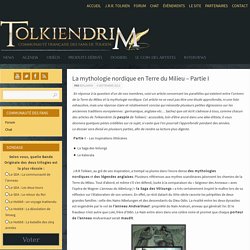
Cet article ne se veut pas être une étude approfondie, ni une liste exhaustive, mais une réponse claire et relativement concise qui nécessite plusieurs petites digressions sur les anciennes traditions européennes : germanique, anglaise etc… Sachez que cet écrit s’adresse à tous, comme chacun des articles de Tolkiendrim (le peuple de Tolkien) : accessible, loin d’être ancré dans une idée élitiste, il vous donnera quelques pistes crédibles sur ce sujet, si vaste que l’on pourrait l’approfondir pendant des années.Le dossier sera divisé en plusieurs parties, afin de rendre sa lecture plus digeste.
Partie I – Les Inspirations littéraires La Saga des VolungsLe Kalevala. J. R. R. Tolkien's influences. While highly creative, the fiction of J.
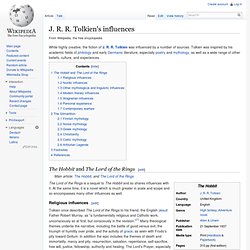
R. R. Tolkien was influenced by a number of sources. Tolkien was inspired by his academic fields of philology and early Germanic literature, especially poetry and mythology, as well as a wide range of other beliefs, culture, and experiences. The Hobbit and The Lord of the Rings[edit] The Lord of the Rings is a sequel to The Hobbit and so shares influences with it.
Religious influences[edit] Tolkien once described The Lord of the Rings to his friend, the English Jesuit Father Robert Murray, as "a fundamentally religious and Catholic work, unconsciously so at first, but consciously in the revision Nordic influences[edit] Tolkien's Elves and Dwarves are by and large based on Norse and related Germanic mythologies[8][9] Two sources that contain accounts of elves and dwarves that were of interest to Tolkien were the Prose Edda and the Elder or Poetic Edda. Other mythological and linguistic influences[edit] The extent of Celtic influence is debatable. File:Odin and Sleipnir - John Bauer.jpg — Wikimedia Commons. The Grey Wizards: Odin and Gandalf. A statue of Odin rests on my altar.

It portrays Odin seated upon his throne, with two ravens perched on his shoulders, telling him of the worlds’ news; at each side of him sit two wolves. He holds a spear or staff in his right hand and a drinking horn in his left hand. The drinking horn is decorated with runes. A symbol of three interlocking triangles is on his chest. The back of the statue depicts Odin hanging from the World Tree as a sacrifice. Before I bought the statue of Odin, I did not have a God figure on my altar for years. What Are the Significant Similarities and Differences Between Gandalf, Odin and Merlin? Gandalf. "Gandalf was shorter in stature than the other two; but his long white hair, his sweeping silver beard, and his broad shoulders, made him look like some wise king of ancient legend.
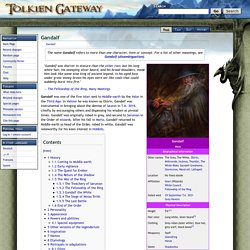
In his aged face under great snowy brows his eyes were set like coals that could suddenly burst into fire. " ― The Fellowship of the Ring, Many Meetings Gandalf was one of the five Istari sent to Middle-earth by the Valar in the Third Age. In Valinor he was known as Olórin. Gandalf was instrumental in bringing about the demise of Sauron in T.A. 3019, chiefly by encouraging others and dispensing his wisdom at pivotal times. [edit] History Olórin was a Maia who dwelt in the gardens of Irmo in Valinor but he often visited the Halls of Nienna.
He loved the Elves but he walked unseen among them, or wore a fana that appeared like an Elf, and sent them fair visions in their hearts that made them wiser. [edit] Coming to Middle-earth. Lord of the Rings Fanatics Archive. In Norse mythology, Gods have many different names.
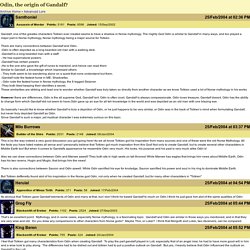
These different names indicate the role they play, their actions and their attitudes. For example, under a certain name Odin can be the exact same as Gandalf... Compassionate, helpful, mysterious, powerful, etc... Under another name he would be a feared God who was extremelly ambitious, and would desert/work against noble warriors in battles (Ex: Lay of the Volsungs).
A jealous and unforgiving God too (reason why most Nordic folk preferred Thorr as their God of choice). Gandalf. Un article de Wikipédia, l'encyclopédie libre.
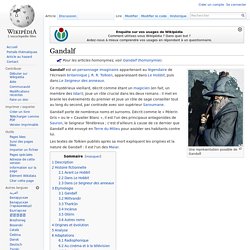
Une représentation possible de Gandalf. Gandalf est un personnage imaginaire appartenant au légendaire de l'écrivain britannique J. File:Ed0002.jpg — Wikimedia Commons. Odin. Pour l’article ayant un titre homophone, voir Audin.
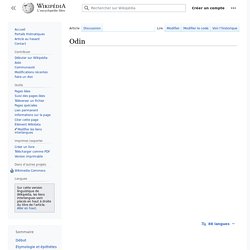
Odin (du vieux norrois Óðinn) est le dieu principal de la mythologie nordique. Il existe dans la mythologie germanique en général, où il est appelé Wōden en vieil anglais, Wodan en vieux saxon des Pays-Bas ou Wotan en vieux haut-allemand ou Gaut. Son nom proto-germanique est *Wōdanaz. L'étymologie de son nom fait référence à Ód, et signifie « fureur », aux côtés d'« esprit » et de « poésie », d'où l'allemand Wut (fureur) et le néerlandais woede de même sens. C'est un dieu polymorphe.